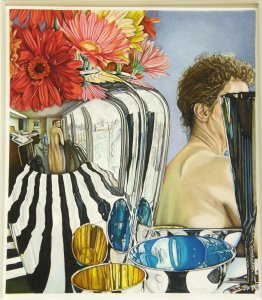Cover Art Commentary: Gregg Hertzlieb on Jeanette Pasin Sloan

Jeanette Pasin Sloan (b. 1946)
Untitled, undated
Colored pencil on paper, 18 1/4 x 16 inches (image), 25 3/4 x 22 1/8 inches (paper)
Gift of the Artist and the Byron Lee and Josephine Luecke Ferguson Donated Fund
Brauer Museum of Art, 2011.01.101
The Brauer Museum of Art at Valparaiso University is fortunate to have in its permanent collection the complete archives of papers and printed works, as well as a substantial number of drawings and paintings, by the artist Jeanette Pasin Sloan, formerly of Chicago and now living and working in Santa Fe. Thanks to the generosity of the artist and Brauer donors Josephine and Byron Ferguson, the Brauer Museum is able to present Sloan’s work in great depth, with earlier efforts in realism foreshadowing the later super realism for which she is best known. Sloan’s works in every medium show confident, even virtuoso, handling in terms of the achievement of various effects as well as the remarkable rendering of highly reflective surfaces. This particular untitled colored pencil drawing highlights reflections, and in so doing causes viewers to think about terms in art, genres in art, rhymes in language and art.
Sloan highlights reflections through capturing highlights and reflections. Surrounded by red flowers and chrome bowls with yellow and blue interiors (the prominent presence of the primary colors conceptually setting the work within the realm of creative metaphor?), the artist in self-portrait, in literal and pensive reflection, looks to the right. An assertive graphic patterning of black and white creates polished silver before viewers’ eyes, with areas of color existing as islands for attention. Represented by the generalized form of a standing nude, the artist turns from the studio interior to gaze at the bathing white light and bare trees through the window. The reflected nude’s counterpart is caught in reflection, her face obscured by a tall glass vessel. She is vulnerable in her nudity, a still life herself amid portraits of cups and flowers. Sloan deftly blends genres so that through making life still, she can reflect on reflections and her place within them. Landscapes exist within the still reflections while outside is the figure that ponders what lies beyond as well as what lies within surfaces.
Sloan’s meticulous use of the colored pencil, which requires considerable effort in application to achieve the opacity and level of shading she has achieved here, indicates a faithfulness of transcription, a graphic sensibility tied to communication and veracity, that gives a sense of the artist’s commitment to the scene. Viewers are not solely drawn to the language of the medium in modernist fashion but instead see through the medium to the scene, with the artist in profile, her face hidden perhaps to prevent viewers from being distracted by likeness, sitting near her classic chrome still life objects and lush flowers while light and insight offer the context of a working artist. Sloan rests and restlessly searches within and without to capture appearances and essences.
The obscured face is a challenging aspect of this picture, foiling expectations in a way that can feel jarring. The artist steers focus from a portrait of a face and body to a portrait of a person willing to reveal all in a quest for revelation. Without clothes, she is a human agent that stands in for the specificity of daily life. In her studio, she is both author and muse, someone who creates a reality that presents her life as an artist at the same time she shows a reality endlessly complex and fascinating in its layers of texture and associations. The artist’s message here is an urging to see, to think about seeing with the eye and mind, so that figure, landscape, and objects all become subjects juxtaposed, containing each other, becoming each other, embracing multitudes.
Blooms and colorful bursts sit atop a vase that contains and reflects a story. Inside and outside, the artist bares herself to become her work. She endures, she still lives, to make art, and to make art use primary tools to transcend bodies, receptacles, shells. The work is a process to be seen past, seen through, until what remains is a composite that survives what it is made of and what it faces ahead.
The joyousness of the floral color and realism aside, Sloan’s drawing suggests determination, perhaps even resignation. She goes on, she continues, she acknowledges that with all there is to savor the work of seeing goes on, continues outside the frame in fact. Art offers destinations and does so relentlessly, and the artist must reflect this truth as long as the flesh holds.
Gregg Hertzlieb is Curator and Director of the Brauer Museum of Art at Valparaiso University. Hertzlieb is the editor of the books The Calumet Region: An American Place (Photographs by Gary Cialdella), published in 2009, and Domestic Vision: Twenty-Five Years of the Art of Joel Sheesley (2008), as well as a contributor to The Indiana Dunes Revealed: The Art of Frank V. Dudley (2006). He has been awarded the Edward L. Ryerson Traveling Fellowship by the School of the Art Institute in Chicago and a Conant Writing Award for Poetry from Millikin University. His artwork has been exhibited widely, including at the Aron Packer Gallery, August House Studio, the Central School of Art and Design in London, Columbia College, Elgin Community College, the Goodman Theater, Struve Gallery, and the Ellen Firme Gallery.